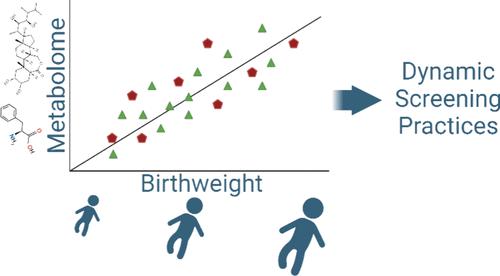超越目标新生儿筛查:研究出生体重-代谢组相关性的非目标代谢组工作流程
IF 6.7
1区 化学
Q1 CHEMISTRY, ANALYTICAL
引用次数: 0
摘要
新生儿筛查(NBS)是美国最大,最成功的预防性公共卫生举措之一,改善新生儿先天性代谢错误的结果。推荐的均匀筛选面板上的大多数疾病都使用三重四极杆质谱法和流动注射分析进行筛选。虽然这些方法非常敏感,非常适合高通量定量应用,但测量分析物的广度仅限于相对少量的生物标志物,这些生物标志物通常在健康人群和患病人群之间有相当大的重叠。基于高分辨率液相色谱-质谱(LC-MS)的代谢组学现在能够分析数千种代谢物,使其非常适合探索性和生物标志物发现研究。为此,我们开发了一个强大的工作流程,用于对干血斑(DBS)标本进行非靶向LC-MS分析,覆盖了与NBS相关的许多代谢途径。HILIC色谱法可以定量氨基酸和酰基肉碱种类,同时也保留了脂质种类,如溶磷脂酰胆碱。我们分析了810个新生儿来源的DBS样本,涵盖了广泛的新生儿出生体重,确定了与代谢物的相关性,这有助于更好地解释某些NBS标记物(如异戊基肉碱)的较低准确性。此外,我们利用这种非靶向工作流程来捕获与肠外营养管理和母体尼古丁暴露相关的新生儿的新生物标志物和代谢表型。两个关键的生物标志物被确定为目标筛选面板的有用补充:n -乙酰基酪氨酸作为肠外营养管理的定性标记,n -乙酰基腐烂胺作为控制出生体重变异性的定量标记。本文章由计算机程序翻译,如有差异,请以英文原文为准。

Beyond Targeted Newborn Screening: A Nontargeted Metabolomics Workflow to Investigate Birthweight–Metabolome Correlations
Newborn screening (NBS) is one of the United States’ largest, most successful preventative public health initiatives, improving outcomes for newborns with inborn errors of metabolism. Most disorders on the Recommended Uniform Screening Panel are screened using triple-quadrupole mass spectrometry and flow injection analysis. While these methods are sensitive and well suited for high-throughput quantitative applications, the breadth of measured analytes is limited to a relatively small number of biomarkers, which often have considerable overlaps between healthy and diseased populations. High-resolution liquid chromatography–mass spectrometry (LC–MS)-based metabolomics is now capable of profiling thousands of metabolites, making it well suited for exploratory and biomarker discovery studies. To this end, we developed a robust workflow for performing nontargeted LC–MS analysis on dried bloodspot (DBS) specimens with coverage across many metabolic pathways relevant to NBS. HILIC chromatography enabled quantitation of amino acid and acylcarnitine species while also retaining lipid species, such as lyso-phosphatidylcholines. We analyzed 810 newborn-derived DBS samples across a wide range of newborn birthweights, identifying correlations with metabolites that help to better account for the lower accuracy observed for some NBS markers (e.g., isovalerylcarnitine). Additionally, we leveraged this nontargeted workflow to capture new biomarkers and metabolic phenotypes in newborns associated with parenteral nutrition administration and maternal nicotine exposure. Two critical biomarkers were identified as useful additions to targeted screening panels: N-acetyltyrosine as a qualitative marker for parenteral nutrition administration and N-acetylputrescine as a quantitative marker for controlling birthweight variability.
求助全文
通过发布文献求助,成功后即可免费获取论文全文。
去求助
来源期刊

Analytical Chemistry
化学-分析化学
CiteScore
12.10
自引率
12.20%
发文量
1949
审稿时长
1.4 months
期刊介绍:
Analytical Chemistry, a peer-reviewed research journal, focuses on disseminating new and original knowledge across all branches of analytical chemistry. Fundamental articles may explore general principles of chemical measurement science and need not directly address existing or potential analytical methodology. They can be entirely theoretical or report experimental results. Contributions may cover various phases of analytical operations, including sampling, bioanalysis, electrochemistry, mass spectrometry, microscale and nanoscale systems, environmental analysis, separations, spectroscopy, chemical reactions and selectivity, instrumentation, imaging, surface analysis, and data processing. Papers discussing known analytical methods should present a significant, original application of the method, a notable improvement, or results on an important analyte.
 求助内容:
求助内容: 应助结果提醒方式:
应助结果提醒方式:


